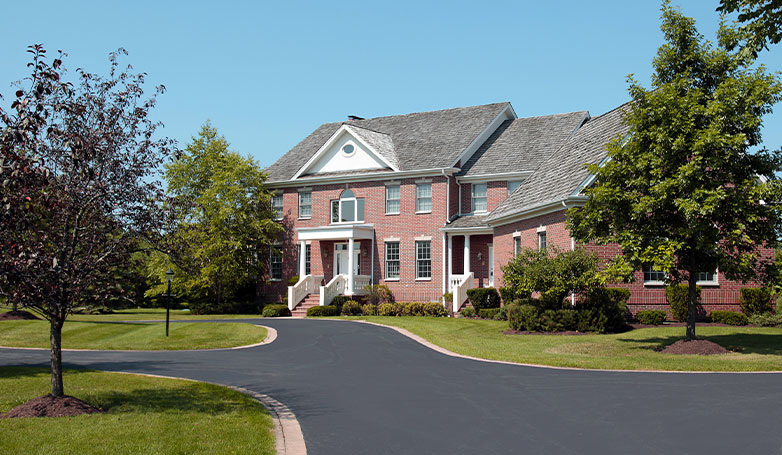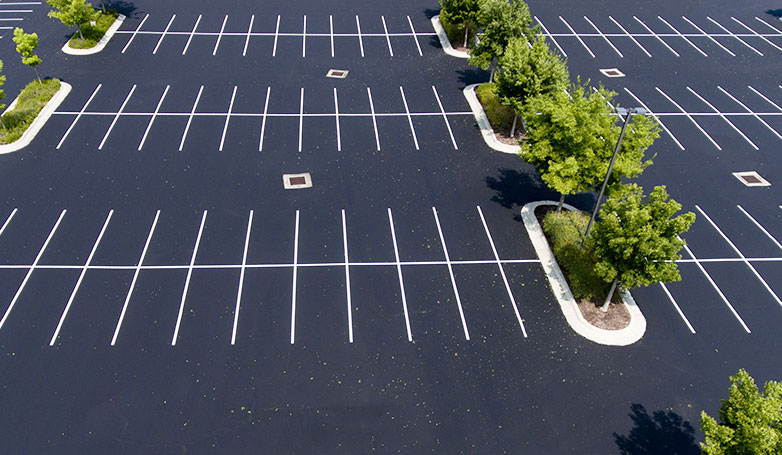Why Does Asphalt Crack?
One of the most prevalent types of damage to asphalt surfaces is cracking. Cracks are the last thing you would hope to see on your asphalt pavement. Although cracks can happen naturally with age, they should not be of a considerable amount or size until several years after installing the pavement.
Cracking is unavoidable in an older parking lot or driveway, but you would be right in believing that it does not happen in a newly built parking lot or driveway. You could be curious to know how this might happen and whether you could have done something to avoid it.
But, what is asphalt cracking?
Asphalt cracking means a range of types of asphalt pavement damages that occur on the pavement surface. Various types of asphalt pavement undergo different cracks. The form of cracking is also associated with the kind of traffic and environment.

So, why does asphalt crack?
Asphalt develops cracks for different reasons, including when it is undergoing fatigue associated issues due to aging and traffic loading. It can also be due to incorrect pavement thickness, environmental influence, poor installation, sub-base instability, changing temperatures, Incorrect base thickness, improper maintenance, etc.
Finding issues early and having them resolved quickly could save you a considerable amount of money and time.
Are asphalt cracks bad?
Asphalt cracks pose a severe threat to your pavement’s longevity if not addressed timely. These cracks will allow water to enter the underlying layers, triggering more damage if not appropriately fixed on time.
If you fail to adhere to your asphalt pavement’s proper maintenance, it will cause the surface to degrade visibly within 3-5 years of installation. However, your asphalt will have a useful service life of 15 to 20 years if you give it adequate maintenance.

The most common causes of asphalt cracks and failures
The most common causes of asphalt cracks or failures are highlighted below:
- Improper thickness of asphalt
- Improper thickness of the base
- Age and Lack of maintenance
- Moisture
- Sun exposure
- Freeze and thaw cycle
Asphalt paving will offer your driveway an inexpensive, safe, and aesthetically appealing surface. But cracks and other issues can adversely affect the appearance, causing early degradation. Always ensure that your asphalt driveway is promptly fixed and maintained regularly for a longer and improved service life. You can avoid further damage to your pavement when you address asphalt cracks within a shorter time. Below are the common causes of asphalt cracks or failures:
Improper thickness of asphalt
Many homeowners ask why asphalt cracks and whether the surface thickness really affects it. The truth is, asphalt thickness can determine what becomes of your pavement surface. Typically, an asphalt surface thickness should be at least 2 inches to withstand moisture, and heavy traffic. If the pavement surface is too thin or the paving contractor improperly installed the pavement, it will become vulnerable to extensive cracking.
Improper thickness of the base
Another thing that can cause the pavement to develop cracks is incorrect base thickness. The base thickness should typically be in the range between 4 to 6 inches. If the base thickness is not up to par, it will ultimately result in cracks on the asphalt pavement surface, resulting in significant damage if not corrected on time.
Age and Lack of maintenance
It is common for asphalt pavement to crack as it ages due to continuous exposure and temperature changes. Thankfully, with a proper maintenance routine, such as seal coating and crack sealing, water-related damages, etc., can be deterred. Also, with an annual evaluation of your pavement, several cracks can be detected and easily fixed.
Moisture
Moisture can attack and wash away an asphalt pavement’s gravel and sand foundation, allowing the surface layer to move and split, leading to cracks of different sizes. When water penetrates a paved surface, it can start to wash the pavement base causing the top surface layer to become damaged, contributing to cracking.
Sun exposure
When the sun beats down on asphalt pavement, it creates heat and breaks down the aggregate material substances. But why does asphalt crack as a result of sunshine? Sunshine usually dries up asphalt surfaces, and just as moisture triggers cracks in asphalt, insufficient moisture can cause similar issues.
Freeze/thaw cycle
Winter freeze-thaw cycles occur when water always seeps into cracks, freezes, and expands. As water seeps into an existing crack on the asphalt surface to the basement, it freezes and expands, and ultimately causes cracking.

The different types of asphalt cracks
The different types of asphalt cracks are listed but not limited to the following:
- Alligator Cracks.
- Edge Cracks
- Block Cracks
- Longitudinal cracking
- Transverse cracking
- Reflective cracking
- Slippage cracking
Alligator Cracks
This type of crack usually spreads across your pavement and resembles the skin of an alligator. It occurs due to failure in the pavement’s structure.
Edge Cracks
Edge cracks are longitudinal in nature. They move inside the surface of the pavement within one to two feet. They are typically triggered by heavy traffic, lack of pavement edge support, soil drying, incorrect drainage, etc.
Block Cracks
Block cracks are huge interconnected rectangular cracks developed on the pavement surface. They are commonly caused by asphalt shrinkage, insufficient moisture, etc.
Longitudinal cracking
These are cracks formed parallel to the asphalt’s center surface. They are commonly triggered by longitudinal segregation, inferior constructed joints, asphalt shrinkage, etc.
Transverse cracking
Transverse cracking happens perpendicular to the asphalt’s centerline, typically caused by the asphalt layer’s shrinkage.
Reflective cracking
Reflective cracking develops over previous cracks in asphalt pavement or the degraded pavement’s surface, causing old pavement movement. So why do asphalt cracks of this type happen directly on the underlying joints or cracks? The reason is, existing cracks lack the initial bond that exists between the asphalt aggregates.
Slippage cracking
Slippage cracking is crescent in shape. These cracks are formed due to the poor bond between the layers of a pavement or weak asphalt mix.

How to properly maintain asphalt to avoid most issues
It is essential to develop a good maintenance culture that would perfectly address any issue that your pavement may encounter as it ages. This is to prevent further damages to your asphalt pavement. The most common ways to properly maintain your pavement are by:
- Proper drainage
- Cleaning
- Sealcoating
Proper drainage
The main reason why pavements collapse is water. Water can get through cracks and down to the subgrade, either eroding it or freezing it, leading to cracking. Hence, it is vital to design a proper drainage system to allow water to flow easily over your pavement, rather than stagnating on it.
Cleaning
Cleaning is often the simplest remedy when it comes to asphalt pavement maintenance. If you are still looking to answer the question why does asphalt crack and whether cleaning can help remedy the issue, the truth is, cleaning up the pavement from debris frequently exposes problems that can be addressed before they get severe.
Regularly cleaning your pavement offers you a chance to analyze the state of every inch of your pavement. It would be best if you periodically cleared dirt, trash gravel, fallen leaves, and other debris because moisture can be absorbed and stuck under these piles, causing severe issues to your pavement. When you remove glass and debris from your pavement, it will also help prevent tourists from perforating their tires.
Sealcoating
Sealcoating preserves and increases the service life span of asphalt pavement by covering surface defects and offering a protective coating to keep harmful UV rays, water, and vehicle fluids. To give your pavement a fresh look and protect it from damages, you need to perform seal coating every 3 to 5 years. If you fail to carry out periodic seal coating, your pavement will be left unprotected from external factors and elements.

Related Articles:
What is the best solution to degrading asphalt pavement?
It is crucial to properly seal asphalt pavement after some months of installing it to prevent significant degradation, reducing the pavement’s expected lifespan. However, before considering seal coating, seasoned professionals must handle the initial ground preparations and pavement surface installation with caution.
While seal coating can be a quick repair and address asphalt cracking issues, repeatedly applying it can make the surface of the pavement look like broken ceramics glazed windows. Sealcoat is an important option for your pavement. Still, you should consider asphalt paving instead if your pavement is a crucial aspect of your property or if it takes customers to your place of business.
Conclusion
As highlighted earlier, there are many reasons why asphalt cracks. While asphalt cracking is a common pavement issue, it is vital to promptly address the issue before it escalates to a more severe case that would cost you more money. Cracks don’t just happen overnight; they have different causes. Proper maintenance is a perfect route to addressing every pavement issue.
Furthermore, it is recommended to seek professional advice when it comes to pavement problems, including cracks. Professional paving contractors have the expertise to analyze the causes properly and adequately draft outlasting remedial methods that would help your pavement fulfill its service life expectancy.


